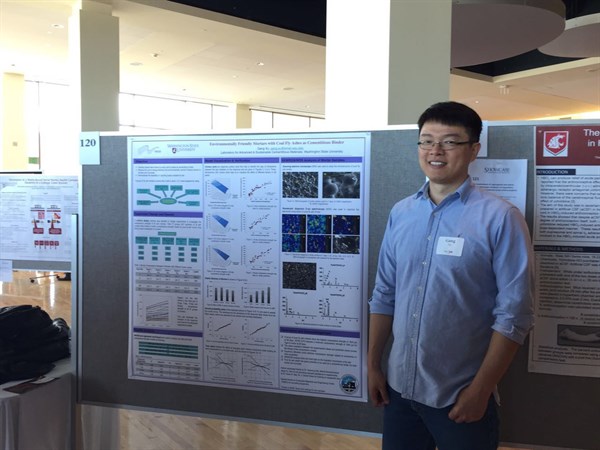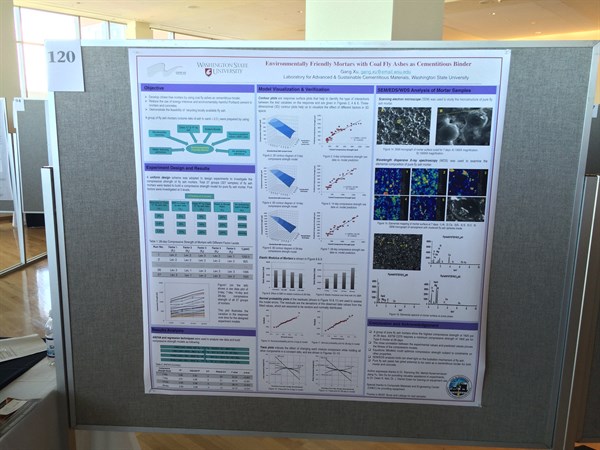News
Apr 06, 2015
WSU Student Presents CESTiCC Funded Research
Academic Showcase is an opportunity for the University community to celebrate Washington State University's central mission: the advancement of scholarship, research, and the arts.
On March 27, scholars from across all disciplines, all campuses and from Extension offices around the state will gather on the Pullman campus to showcase recent original research, scholarship, and/or creative work. Dr. Xianming Shi's PHD student Gang Xu presented his research entitled, "Environmentally Friendly Mortars with Coal Fly Ashes as Cementitious Binder."
In the effort of reducing the use of energy-intensive and environmentally harmful Portland cement in the pervious concrete while making cement-based mortars and concretes more environmentally sustainable at potentially lower cost, this work explores the development of clinker-free mortars using coal fly ashes as cementitious binder. Fly ash, as an industrial byproduct from coal-fired power plants, has been used to partially replace the Portland cement as a binder for many years. However, a 100% fly ash replacement of ordinary cement in the mortars and concretes is a relatively unexplored area with great potential. This will not only divert the fly ash from the waste stream, but also greatly reduce the environmental footprint of the concrete industry. In this study, a variety of coal fly ash mortars (CFAMs) were prepared at room temperature and without direct alkali activation. The samples were prepared using only the as-received class “C” and class “F” coal fly ashes (and trace amount of borax and montmorillite nanoclay), styrene-butadiene rubber (SBR) latex, water, and a small amount of water reducing and air entraining admixtures. A uniform design scheme was adopted to design experiments, which minimizes the number of experiments required to investigate a large domain of unknown factors and interactions. Five factors, nanoclay to class “C” fly ash ratio, SBR to class “C” fly ash ratio, class “F” to class “C” fly ash ratio, water to binder ratio, and air-entraining agent dosage were investigated, each at three levels. A total of 135 mortar samples were prepared in the laboratory to examine effects of these five factors and their interactions on the workability of fresh mortar and on the 14-d and 28-d compressive strength, elastic modulus, toughness, and surface resistivity of hardened mortar. The CFAM mix design was then optimized based on workability, mechanical, and properties mentioned above. This preliminary work demonstrates the feasibility of upcycling locally available industrial byproducts (coal fly ashes) in mortars and lays the foundation for their use as cementitious binder in concrete materials. Future work will focus on mechanistic investigation of “best-performing” mortar and the use of such “green” binder(s) in pervious concrete.
During the 3-hour exhibition, numerous people showed interest in this poster and asked questions about how fly ashes work as a cementitious binder.



